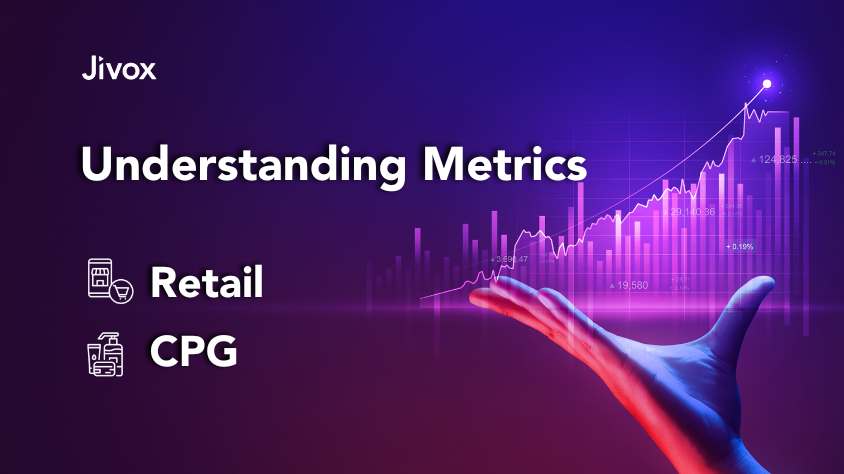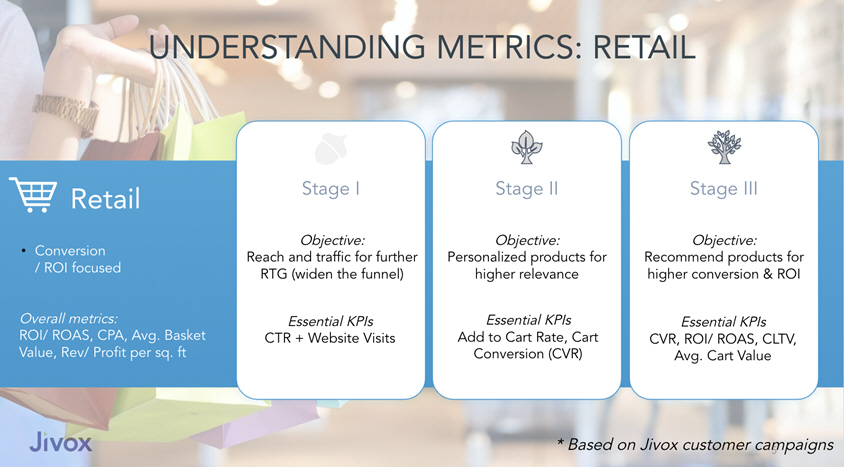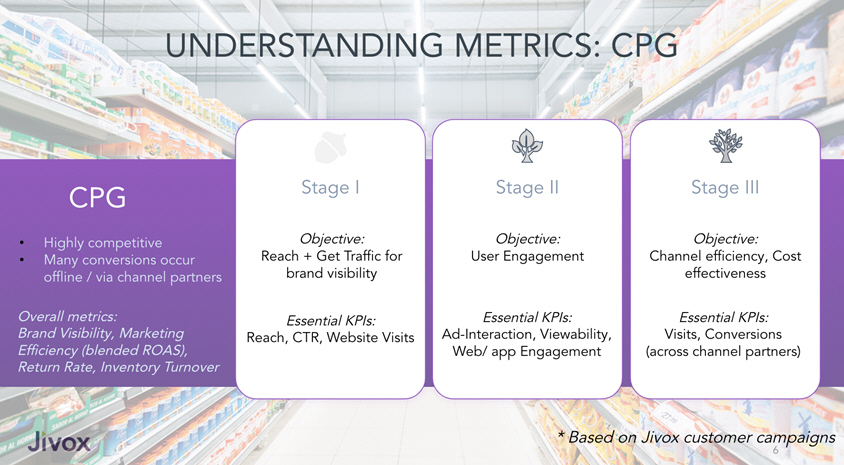The Retail & CPG edition

Coming up with a key performance indicator (KPI) isn’t something any marketing team should take lightly. It’s a guiding metric to check the health of your business. When you go to see a physician about your blood pressure, they’re using a standard to measure against. Similarly, your brand needs a standard or KPI to measure your marketing performance against.
Take me to:
But just as you wouldn’t use the average blood pressure rate to measure your eyesight, you wouldn’t just pick any old KPI to guide your company.
But just as you wouldn’t use the average blood pressure rate to measure your eyesight, you wouldn’t just pick any old KPI to guide your company.
Your KPI needs to be precise, suit your objectives and north star metrics for your type of business and the industry you work in.
Your KPI needs to be precise, suit your objectives and north star metrics for your type of business and the industry you work in. But even more specifically, the KPI you’re using to measure your personalized marketing campaigns needs to be suited for the stage of personalization you are at, along with the level of data available to you to evaluate performance.
But what are these personalization stages?
Move beyond CTR >>
The Three Stages Of Marketing Personalization
At Jivox, we’ve loosely translated the collected experience with multiple customers in the retail and CPG industry into three stages of personalization – Stage I, II and III. Each stage addresses a combination of how sophisticated your personalization is along with the amount of data you have on your target audience. Some brands have only just started personalizing ads to individual consumers (Stage I) while others have a personalized customer journey locked down across the entire spectrum of marketing channels (Stage III). Irrespective of which stage brands are in, they’ll need KPIs that allow them to grow to the next stage, not ones that expect too much of one metric or not enough of another.
An important point to note here, is that while these metrics are a great starting point, they will vary across brands as every brand is unique. There are always outliers that will need to be more discerning about the KPIs they use as they may have different objectives and how campaign performance aligns with business goals..
In part 1 of our Mastering Metrics series, we’re focusing on the KPIs we’ve seen grow successfully across the marketing funnel and at each stage of personalization, in the retail, e-commerce and CPG industries within our customer base.
Ask yourself these questions
At this stage, what are my marketing campaign’s objectives?
What KPIs are relevant for measuring success against these objectives?
By the end of this blog, you should have answers to the above questions with which you’ll be able to check the health of your personalization strategy effectively and how these KPIs are helping your brand grow their marketing ROI.
Marketing KPIs For Retail & E-Commerce
Brands in this space are fortunate to have access to a lot of data on their customers.
This will help move along their personalization efforts as more granular data points mean more precise insights into a broad range of metrics that can help identify where to advance their personalization strategy further. And that benefit will aid the conversion-centric metrics that retail and e-commerce brands typically focus on.

Stage I:
At this stage, brands might be running simple prospecting campaigns and basic retargeting campaigns due to lack of data. Brands are running prospecting campaigns to gather more data to fuel their retargeting campaigns. The main focus here is driving traffic to the brand’s website to capture data for more advanced retargeting campaigns. Brands will need to establish enticing offers in their ads to convince consumers to come back to their site.
CTR is important at this stage for brands to assess the quality of their ads and landing page visits help brands understand whether the page has sufficient information and is designed in a user-friendly manner for consumers to make buying decisions.
Essential KPIs: Clickthrough rate, website or landing page visits, basic conversions.
Stage II:
After brands have gathered a sufficient amount of data, they’re able to run more advanced retargeting campaigns. At this stage, brands are deep into personalizing ads with more relevant assets and messaging to the consumer. Conversion rates will be climbing as the brand’s ads hit the right audience with the right message.
Brands will have to make sure they’ve established a sufficient workflow with updated product feeds to make sure they’re only retargeting consumers with products that are relevant, in stock, or on offer. They’ll also need constant updates on pricing so that the ads can reflect the most relevant promotions or brick and mortar pricing accurately.
Campaigns running at this stage will give brands access to a lot more data points, taking them a step further in identifying which products are performing well in comparison to under-performers.
KPIs here will be metrics at the point of sale. The goal will ultimately be related directly to conversions.
Essential KPIs: Product search, Time spent on landing page, Add-to-cart, Initiate checkout, number of complete orders, Cart conversion rates.
Stage III:
This is where brands are starting to master their personalization strategies and are now bringing in smart efficiencies to boost their marketing ROI across multiple channels. They’re likely using AI to recommend products to consumers and focusing on a streamlined workflow in their product feeds.
They’ll be able to adjust campaigns to reflect new promotions within hours by making simple adjustments to their product and offer feeds.
Additionally, these brands will have a significant set of first-party data and identifiers across platforms and channels, so they can assess the lifetime value of their customers.
With DCO, brands at this stage get access to granular data points so they can understand which channels and formats are performing well and need to be optimized further. They’ll be thoroughly reaping the benefits of optimized digital marketing campaigns.
Essential KPIs: Conversion rates, cost per conversion, average cart value, revenue, customer lifetime value, ROI, ROAS, Profitability, marketing efficiency ratio.
Marketing KPIs For Consumer Packaged Goods (CPG)
CPG brands don’t have as much data on their customers as retail brands given their more indirect relationship with the consumer.
As a result, they focus their budgets on visibility and driving customers to stores. Most of their conversions take place offline or with online partners.
This fundamental difference between CPG and retail means that their personalization stages are going to be different. If you’re in the CPG industry, your KPIs may have historically been more focused on measuring brand engagement and awareness.

Stage I:
Stage I however, is very similar for both CPG and Retail brands. They’ll be concerned with running simple prospecting campaigns, focused on building visibility and increasing website or landing page traffic. These brands will similarly use the data collected from these site visits to run retargeting campaigns.
Essential KPIs: Reach, clickthrough rate, website visits, viewability, ad engagement.
Stage II:
At this stage of personalization, CPG brands are focused on user engagement in videos or ads. They’ll have sophisticated retargeting campaigns using contextual triggers to further personalize their ads. Additionally, CPG brands will be experimenting with a variety of ad formats on different channels. Their campaigns will be focused on metrics that reveal levels of engagement. They’ll therefore, want their KPIs to answer some important engagement-related questions:
- Are people spending time on my site/landing page?
- Are people connecting to the story around my products?
Essential KPIs: Ad interaction, viewability, website/app engagement, video completion rates, brand lift survey results, interactive unit metrics such as carousel sliders, traffic to external e-commerce sites.
Stage III:
CPG brands at this stage have reached a large audience but are looking to improve the relevancy of their campaigns across multiple channels. They also want to improve efficiencies by optimizing their channels, ad formats and creative combinations. So not only are these brands looking at the amount of visitors from a channel, but assessing the cost as well. This marketing optimization is what sets them apart from brands at previous stages of personalization.
At this stage, CPG brands will also be assessing data, especially conversion data from their channel partners that host their products. This will help fill some data holes that come with selling indirectly to consumers.
Essential KPIs: Cost per visit from a channel, Conversions across channel partners, offline conversions, in-store traffic, brand affinity, share of voice, amplification rates.
Next Steps: Monitor & Optimize Effectively
With your key metrics in mind, the next step to successful DCO campaigns is to monitor and optimize these metrics effectively.
Here’s how brands can master metrics with Jivox IQ Blaze Analytics:
- Create Custom LiveBoards: Pin essential KPIs and corresponding sub-metrics and get instant actionable insights that are updated in real-time. The media team can then use this information to further optimize.
- Set KPI Alerts: Teams can set thresholds for essential KPIs and sub-metrics and receive instant email notifications when surpassed.
- Stick to your BI tool of choice: Teams can export this level of granular data to any tool of their choice with a click of a button.
After reading this post, if you want to dive a little deeper into:
- Which stage of personalization your brand falls under?
- How much data does your brand have access to? And how can it get access to more?
- How can your brand leverage data and analytics to move from one stage to the other?
- Whether your brand is using the right KPIs to measure success?